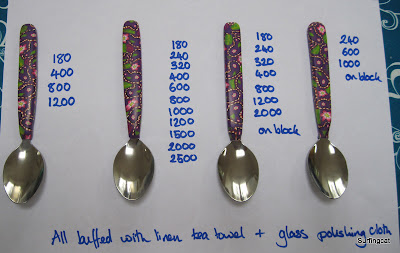Today I sat down with some paisley spoons and my usual sanding set up (a narrow tray with some warm water and a few drops of washing up liquid in it to help break the surface tension) and 11 different grades of wet and dry sandpaper! For flat objects I put the paper on the tray under the water and sand on the flat surface. For things that aren't flat (such as spoons) I sand above the tray and dip the paper and object in the water when I start to notice a residue. Thinking about it a bowl would be easier when not sanding flat things so will try that next time.
Sandpaper wrapped round a block
I had 4 spoons so tried using 4 different combinations of papers - all finishing on a different grade.
The first thing that struck me was how similar they all were! I thought you would easily be able to tell the difference between the ones that had been finished to a higher grade, but it was hard to tell. My mum even thought that the one on the left, the one finished to 1200 grit sandpaper was a little more shiny. My dad was able to correctly identify the one that had been sanded most (the second on the left that had been sanded through to 2500 grit). After a lot of sitting and feeling them I can now tell the difference too but it doesn't show visably.
How to tell when to move to the next grade of paper? I have found that for me (at this stage in my experience of sanding) I need to dry the piece to be able to tell. If I just go through the grades wet I get to the end and there may still be some scratches. If I stop and dry between grades I can see if it is ready, I can see if there are still marks or not.
So I still have things to try but I am going to stop agonising over which grades to use. I shall try and finish off with some of the higher grades if I am using a buffed finish. I'll let you know how my next lot of trials go.
























We have found that how smooth your clay is before it is baked also determines how much or little you need to sand afterwards. Most of my pieces are quite smooth before sanding so I don't have to sand as much thus why I do it all by hand and not use a rock polisher. I usually start with 320 for larger pieces if there are any larger bumps that I missed before baking otherwise I only use 400 and then 800. I never have to go any higher as I use to and felt there wasn't any difference.
ReplyDeleteI recently sanded some beads. Then had to make three more as they didn't reach round the wrist. I then varnished them. Forgot to sand the final three before varnishing and can't tell the difference! Will monitor your progress on this one.
ReplyDeletePS the Sue Heaser book I have is The Art and Craft of Polymer Clay
ReplyDeleteCarolyn how do you finish after sanding? Do you hand sand little round beads too? I have real trouble with that.
ReplyDeleteFiona I now have some varnish so am going to try it for pretty much the first time (used a bit of Fimo glass varnish in the past but been unhappy with the result). I figured they all look much the same but you can feel a slight difference so that makes sense you can't tell when you apply a finish.
So many more things to work out still!
Believe it or not, we (my hubby and I sand together) sand all our beads -- even the round ones -- by hand. If they are really smooth I will do the 400 grit and then Dave does the 800. I find if he does the 400 he doesn't know his own strength and the beads suddenly aren't round anymore! lol
ReplyDeleteIf the really small beads are quite smooth already I only touch them up with 800 grit. The only ones I don't sand are my little rondelles which really don't need it.
We've tried the tumbler method and we just found it didn't work for us and Dave says he noticed how my beads are so smooth after baking sometimes he thinks they don't even need sanding but we sand them anyways.
I use 600, 800, 1000 and 1200 grit. If a use 1200 for a lot of sanding in the end the beads are lovely after buffing with an old t-shirt.
ReplyDeleteI recently bought micromesh but haven´t tried it out.
I have tried to use 2000 grit and it made a huge difference. More shine and smooth. I read once that one had to use 6 strokes of each grit on the beads. But after A LOT of sanding I´ve got to know my clay and kind of know how much sanding I need. It was all about experience for me.
Good luck!!!